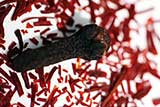Meats and Sausages
Food Colorings
Fruits, herbs and spices produce the natural color that we take advantage of when making beverages. The best additional colorings are caramel (burnt sugar) which colors drinks from light to dark brown and saffron which produces a beautiful yellow color.
- Caramel delivers strong yellow-light brown color. This is the most universally applied colorant.
- Saffron makes rice yellow. It delivers strong yellow color to lemon vodka or to herb infusions.
- Bilberries (European Blueberries) - deliver deep red or burgundy color.
Saffron. Saffron is the world's most expensive spice. It imparts a rich golden yellow hue to dishes (yellow rice) and textiles. Add a few threads to a glass of water and in a few seconds it will be crystal clear yellow. Saffron threads can only be picked by hand and to produce 1 lb (453 g) of dry saffron we have to harvest 50,000 - 75,000 flowers.
There is confusion between European (Vaccinium myrtillus) bilberry and American (Vaccinium cyanococcus) blueberries. They look identical and are used for the same purposes. From Wikipedia: Since most people in the world refer to "blueberries", no matter if they mean the European blueberry Vaccinium myrtillus or the American blueberries, there is a lot of confusion about the two nearly identical fruit worldwide. One can distinguish bilberries or European blueberries from their American counterpart by the following differences: bilberries have dark blue, strongly fragrant flesh, while American blueberries have white or translucent, mildly fragrant flesh; the bilberries grow as single fruit on low bushes, usually wild in woods of the Northern Hemisphere, but American blueberries grow in a large bush with several fruit at once; bilberries are generally wild plants while American blueberries can be cultivated. Bilberry fruit will stain hands, teeth and tongue deep blue or purple while eating; it was used as a dye for food and clothes. American blueberries of section Cyanococcus have white flesh, thus are less staining.
FDA Approved Food Colorings
The following commercially produced food colorings are approved by the USA Food and Drug Administration: Yellow 5, Red 40, Blue 1, Red 3. More sub-colors can be obtained by combining those above colors:


















